What is the underlying cause of swollen eyelids? The common cause of this swelling is the inflammation or occurrence of excess fluid (edema) in the connective tissues surrounding the eye. Swollen eyes can be painful and will in most case affect both the upper and lower eyelids. In this article, we shall provide you with other causes including allergies, images of how the swelling appear, treatment and home remedies to relieve some of the symptoms accompanying the swelling.
Swollen Eyelid Causes
As said, there are numerous causes of the swelling. This will include such things as eye infections, eye injuries or trauma and allergies both food and drug. In some cases, the swelling could be a sign or symptom of a more serious underlying sight-threatening condition. Some of this condition will include orbital cellulitis, Graves’ disease, and ocular herpes.
To avoid complications, we advise you visit your optician as soon as you notice some abnormalities with your eye or around eye. Below we discuss some of the common causes of the swelling.
Swollen Eyelid from Crying
Tears, a watery secretion produces in the lacrimal glands is essential for healthy eyes. The secretion is responsible for keeping the eyes cleansed, protected and lubricated. After excess tears production or crying, it is common for one to have a running nose. This is because tears drain through the nasal cavity.
Tears can be categorized into three types, the first type is basal tears which provide a constant film that keeps the eyes moist, the second type of tears is reflex tears which protect the eyes from environmental irritants such as smoke or when the eyes comes into contact with foreign bodies and finally we have emotional tears produced in response to a strong emotion.
Crying can be said to be a response to an emotional set back or from pain. When crying, the brain will send a response which will send the lacrimal gland into overdrive, this is what leads to a continuous flow of tears. Some tissues will observe the tears, this will give the eye the puffy look or make it appear swollen.
The other cause of swelling after crying is the autonomic nervous system increased blood flow to the face when faced with a strong urge to cry. The swelling is temporary, you could take some simple steps to deal with the swelling after a crying spell. To help keep things in control, you could try the following simple remedies:
- Gently splash water on face to help reduce redness
- A cold compress or an ice pack can help reduce the swelling on face
- To reduce sinus pressure, massage the bridge of your nose for a few minutes, make sure you focus on the area where a pair of glass would rest. Relieving sinus pressure will help reduce the swelling.
- After crying, make sure to have some rest, this should be done while keeping your head elevated. To do this, put some pillow underneath the head. This helps lower blood pressure which will help with the swelling.
Swollen Eyelid Allergy
An allergy occurs when your immune system becomes overactive to foreign substances. This substance is called allergens. Common eye allergens will include certain eye drops and contact lens solutions. An allergic reaction to make-up is also a known cause of swollen eyes.
Blepharitis
This is another common eye condition characterized by the inflammation of the eyelid. The condition is known to cause clumping and stickiness around the eyelashes. The condition is not specific to any age group, it can affect children, the old and people of any gender.
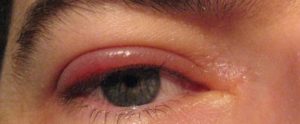
Common symptoms associated with this condition will include itchiness, redness, flaking, and crusting. The condition is not a sight-threatening problem, but it can result in decreased vision which can come and go.
Makeups
An allergic reaction to makeup can also result in the swelling of the eyelid. An eye allergy will develop when your eyes release a chemical to protect them from allergen to which you are sensitive. To remedy an allergic reaction, anti-histamine medication can be used
Hay Fever
This is a common form of an allergic condition known to cause sneezing, running nose and itchy eyes. Severe cases of hay fever can cause the nose, eyes, eyelids, throat and sinuses to become swollen.
Swollen Eyelid in the Morning
In humans, the eyelids also referred to as Palpebral have some of the thinnest skin of the body and serve to protect the eyes. The eyelashes will protect the eye from sweat, dust, and debris. Tears, a liquid secretion of the eye will help keep the eye moist. The swelling, therefore, occurs due to infection and inflammation occurring within the skin and glands of eyelids.
Most cases of puffy eyes are noticed in the morning when you wake up. This is common in old people due to a weakening of the tissues around the eye. The swelling may also result from crying, allergies or hormonal changes that typically goes away when you wake up. This kind of swelling is not a medical concern, they are many ways one can treat the swelling at home without medical interventions.
Bugs under the eye that could be causing the swelling are typically most noticeable when you wake up in the morning. The swelling and dark-eye circles associated with this condition may persist throughout the day. Though the bags are of no medical concern, they may be of great cosmetic concerns to some people. They can make a person appear old and tired. This symptom will in most cases clear when the underlying cause of the swelling has been cleared.
In most cases, the swelling is a symptom of an underlying cause. Whether the swelling is occurring in the morning, evening, or any time of the day, it will be accompanied by one or more of the following symptoms:
- An irritation such as itching or scratchy sensation in the eye
- Most people especially children will have excess production of tears
- Redness and inflammation of the conjunctiva
- Flaky and dryness of the eye
- When especially caused by an infection, severe pain may be felt.
- Depending on the extent of the swelling, you may experience obstructed vision
- Seek medical attention if the above symptoms take more than a week to clear.
Swollen Eyelid Pictures
Below and throughout this article, we have provided some images for visual guidance. The images are for illustration only and cannot substitute a professional health diagnosis. You need to have a doctor diagnose the condition to establish the underlying cause of the swelling before treatment can be prescribed.
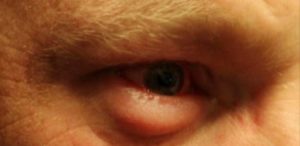
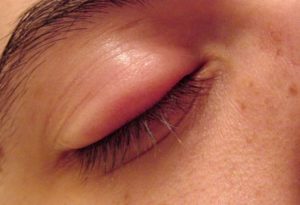
Swollen Eyelid Baby
Most people will overlook newborn babies when thinking about eye infection. A healthcare provider or pediatrician who work with the baby will in most cases associate the swelling with a condition known as neonatal conjunctivitis. This is the inflammation or infection of the conjunctiva the clear lining of the eye and eyelid.
Neonatal conjunctivitis is not the only cause of the swelling, babies may also develop other infection known to cause the swelling. They could include the following:
Blocked tear duct
Blocked tear duct also known as nasolacrimal obstruction is the most common cause of red, crusty eye in babies. The infection will in most cases develop a couple of weeks after birth. According to available statistics, it affect close to twenty percent of newborns.
Common signs and symptoms of the condition will include;
- Blurred vision
- Recurrent eye infection and inflammation
- Redness of the white parts of the eye
- Crusty eyelids
- Discharge from the eye-mucous and pus
- Excessive secretion of tears.
The infection can happen at any age. Sometimes, the blocked tear duct may be caused by a tumor pressing on the tear drainage, this could make the tears fail to drain properly, it could cause watery eyes and increases the risk of eye infection and inflammation. Below we have provided a list of some of the risk factors for developing a blocked tear duct.
- Age and sex older women stand the highest risk of developing this infection
- Those with chronic eye inflammation
- Those who have had surgery before
- Those on anti-glaucoma medication
- Those who had used chemo therapy or any cancer treatment.
Common complication with blocked tear duct is that, the stagnant tears that fail to drain properly, could promote the growth of bacteria, viruses and fungi, this will lead to recurrent eye infection and inflammation. Any part of the eye can become infected.
Bacterial conjunctivitis
As mentioned above, we have seen that conjunctivitis is the inflammation of the thin lining of the eye and eyelids. Bacterial infection of these lining can happen in different ways. The infection could happen at childbirth, this happens when the baby goes through the birth canal. There are bacteria present in woman’s vagina that are not necessarily transmitted sexually. Your baby’s eye may get infected in this way.
There are also a few other types of bacterial infection that could cause more serious infections and potentially blindness in babies. This infection will include Chlamydia Trachomatous and Neisseria Gonorrhoeae. All these bacterial infections can be passed to the baby during childbirth.
Chemical conjunctivitis
This can be said to be an induced inflammation of the eye lining. Eye drop and others ointments used to treat or prevent bacterial infection can irritate your child’s eyes. The irritation could cause the eyes to become very inflamed. This can also be said to be chemical or toxic conjunctivitis.
Viral conjunctivitis
Neonatal conductivities though less common can also be caused by a viral infection. The virus causing oral or genital herpes can occasionally cause infection and serious eye damage to babies. Before childbirth, there is a risk of transmission of the herpes virus from the mother, a cesarean section surgery will be scheduled instead.
Swollen Eyelid and Cheeks
Swollen eyelids and cheek or other surrounding tissue may cause alarm. This is even worse when the eyelids shut or you are suffering from immense pain. A cold compress can help relieve the pain before you have a medical evaluation. Treatment will vary depending on the causes of the underlying symptoms.
Allergy is a common cause of these swelling. Those with severe allergies to food and other triggers may experience this kind of swelling. A food allergy will in most cases, cause localized swelling around lip and cheeks, some people will, however, experience significant swelling around the entire face. An allergy eye drop will help with the eyelid swelling whereas allergy medication may help with overall improvement.
Another condition that could be causing the swelling is angioedema. This is the swelling of the face that typically around eye and lips. The condition is known to cause swelling under the skin that may form welts on the skin top layer. The different condition may trigger this condition including but not limited to allergy. Allergy medication may help with the swelling, if a person, however, experiences breathing problem, then immediate medical attention will be required.
Orbital cellulitis is the other condition known to cause swelling around the eye and towards the cheek. Since the infection spreads, the condition poses a serious threat to the patients. Apart from the swelling, those suffering from this condition will experience other symptoms such as fever, pain, vision changes, fatigue and discoloring of the swollen tissues.
Those with this condition requires immediate medical care, the treatment should also be specialized. For mild cases, different antibiotics may be used, for severe cases, a doctor may recommend surgical drainage of any abscesses.
Swollen Eyelid Corner No Pain
Pain is a common symptom associated with a swollen eyelid. The pain is felt in most case when one tries to blink. When there is no pain, then the swelling will in most cases be a sign of a chalazion. This is a small bump similar to a stye that appears on the eyelid due to blocked oil gland.
Unlike a stye, this kind of bump are painless and will heal on their own within a month with no treatment. Whereas a chalazion appears due to a blocked oil gland, a stye is an inflamed oil gland on the eyelid. The most common symptoms of a chalazion are:
- It appears as a small hard lump
- Causes increased tearing
- Blocked vision
- Sensitivity to light
Swollen Eyelid Pink Eye
Pink eye also knows as conjunctivitis, is the inflammation of the clear lining of the surface of the eye. A swollen eyelid can result from bacterial, viral or allergic types of pink eye. The swelling will in most cases be accompanied by other symptoms such as watery, red and itchy eyes.
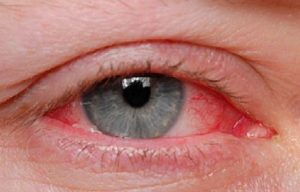
Swollen Eyelid Gland
Bacterial infection and inflammation of the Meibomian gland is the main cause of a stye. It is the blocking of these oil-producing glands that will in most cases cause the swelling of the eyelids.
The blocking of these glands is also responsible for the formation of a chalazion. A chalazion will at first resemble a stye then develop into a hard sebaceous cyst. One difference of the two is that a stye occurs on the edge of an eyelid whereas a chalazion typically develops way from the eyelid edge.
Both of these bumps causes swollen eyelids and tenderness of the affected areas.
Swollen Eyelid Stye
A stye will appear as a swollen reddish bump on the edge of an eyelid. The bump is caused by bacterial infection and inflammation of the Meibomian gland. As the glands get blocked, eyelids swelling becomes a typical symptom.
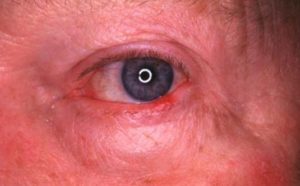
Unlike a chalazion, a stye is tender to touch and could cause the entire eye to swell. The main symptoms of a stye are painful yellow lump on eyelids, redness of the eyes and watery in the eye. After it burst and release pus, most of these bumps will get better without treatment.
Be warned, you should not try to burst the stye yourself. The best way will be to have a professional health care provider look at the painful, irritating stye on your eyelid.
Swollen Eyelid Treatment, Medicine, Relief Cream, Eye Drops
Due to the varying causes of swollen eyes, the treatment and medication for puffy eyes will vary. The treatment will thus depend on the underlying cause of the swelling. If the underlying cause of the swelling is allergies, the best mediation will be antihistamine eye drops or oral allergy medication.
The eye drops used for the swelling will greatly depend on how severe the allergy causing the swelling is. For severe allergic reaction, an eye care profession will recommend mild steroid drops.
Other causes of swelling such as ocular herpes and conjunctivitis, anti-viral medication will be used. Anti-inflammatory eye drop may also be used in such cases. Oral or ointment antibiotics can also be used to help fight bacterial that might result or cause the swelling
Swollen Eyelid Home Remedies
The best way to dealing with swollen eyelid is having a doctor diagnose the condition to establish what the underlying cause of the inflammation is when that is done, your doctor will prescribe medication that will help get rid of the underlying cause of the infection.
While treating the underlying cause, there are available home remedies that will help you relieve the pain and get rid of the swelling. Regardless of the cause of the swelling, you need to completely avoid touching or rubbing the swollen eyelid.
- You also need to resist from wearing makeups,if you use a contact lens, you need to remove it until the swelling clears. Putting a cold, damp cloth on the swollen eyelid can serve well in reducing the swelling on face and eyelids.
- Over-the-counter anti-inflammatorycreams can also help relieve the swelling at home. At times gently tapping your puffy eyelids can help release and drain built-up fluid. Drinking plenty of water can also help with the swelling. This is especially helpful when the underlying cause of the swelling is hydration. Make sure you cut on alcohol consumption as this is said to aggravate dehydration.
- Washing your face or eyes with a solution of warm salty waterhelps draw out water retained in eyes in a process similar to osmosis, the swelling is thus reduced as more water is drained out of the eyelids.
- A chilled tea bag placedon the swollen eyelids is the other way to soothe a swollen and irritated eye. The caffeinated tea will cure the swelling by constricting the blood vessels. The remedy can be applied in two different way, the first way in by placing a used tea bag in a fridge for some minutes then placing it on the infected eyelid while lying down. The other way is by dipping fresh tea bag in hot water, allow it to cool then place it over the eye.
- Chilled cucumberscan also make a good remedy for treating puffy eyes. The enzymes and the astringent properties in cucumber help reduce inflammation and tighten the skin. The remedies are also used to get rid of wrinkles and dark circles around your eyes.
- Egg whitesalso have the same skin-tightening properties that can help banish under eye bags as wells as prevent wrinkles.
- You could also try using potatoes,just like cucumbers, they are effective in getting rid of puffy eyes. The starch in potatoes has anti-inflammatory properties that help reduce under-eye bags. The remedy can also be used for fading dark circles under eyes.
Home Remedies to Treat Swollen Eyelid – Video
https://www.youtube.com/watch?v=wDAy3hF4ulU
Sources and references.
- Swollen eyelids causes: http://www.allaboutvision.com/conditions/swollen-eyelids.htm
- Eyelids problems: http://www.nhs.uk/conditions/eyelid-problems/Pages/Introduction.aspx
- Eyelids inflammation: http://www.healthline.com/health/blepharitis#Overview1
- Home remedy for swollen eyelids: http://www.eyehealthweb.com/swollen-eyelid/
- Reasons for swollen eyelids: https://health.clevelandclinic.org/2016/10/8-reasons-swollen-eye-eyelid/
- Swollen eyelids diagnosis and treatment: https://www.theeyecenterconyers.com/swollen-eyelids/
- Treating a swollen eyelid: http://www.livestrong.com/article/22653-treat-swollen-eyelid/
- Swollen eyelids meaning: http://www.medicinenet.com/swollen_eyes/symptoms.htm
